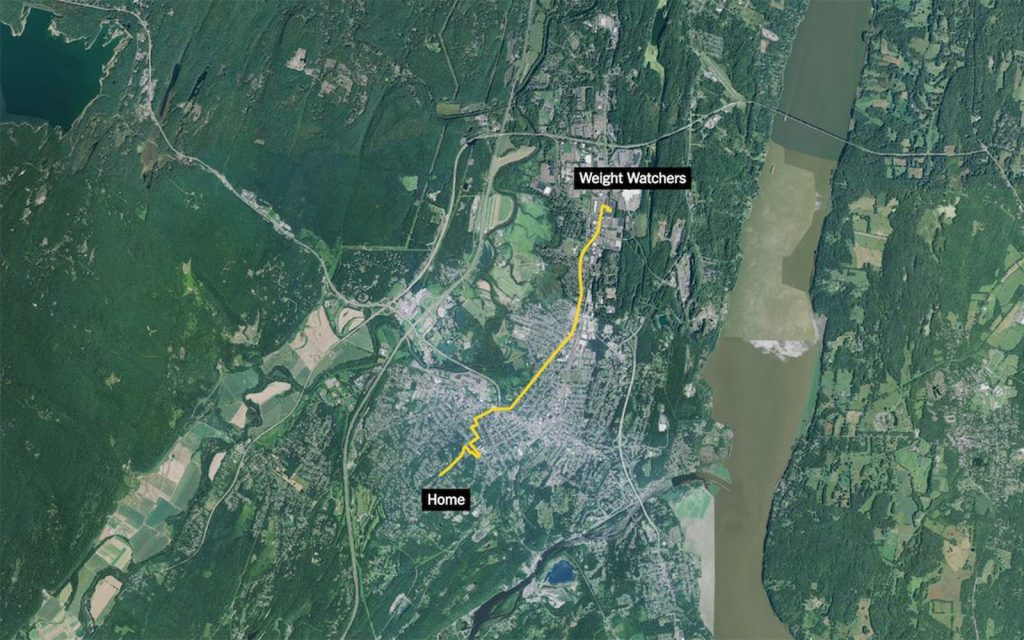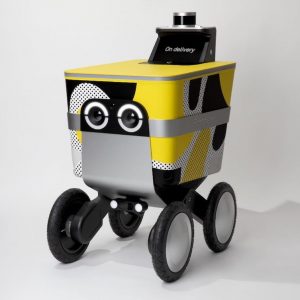Link About It: This Week’s Picks
A movie theater for dogs, NASA’s fastest spacecraft ever, industrial hemp farming and more from the internet this week

Olafur Eliasson Brings 30 Icebergs to London
 Visionary Icelandic-Danish artist and designer Olafur Eliasson, with the help of geologist Minik Rosing, set 30 iceberg, drawn from the waters inside Greenland’s Nuup Kangerlua fjord, along the banks of London’s Thames. It’s the next installment of his “Ice Watch” series, which appeared at Place du Panthéon in Paris back in 2015. Visitors to the installation can climb on, taste, smell and listen to the pieces as they melt away. These encounters aim to allow guests an understanding of what the world felt like before pollution, and remind them about the woes of climate change. 24 can be found in a circular grove outside the Tate Modern; six other blocks rest outside the Bloomberg headquarters in the City of London. The exhibition, which launched on 11 December, runs until the ice has melted. Read more at The Guardian.
Visionary Icelandic-Danish artist and designer Olafur Eliasson, with the help of geologist Minik Rosing, set 30 iceberg, drawn from the waters inside Greenland’s Nuup Kangerlua fjord, along the banks of London’s Thames. It’s the next installment of his “Ice Watch” series, which appeared at Place du Panthéon in Paris back in 2015. Visitors to the installation can climb on, taste, smell and listen to the pieces as they melt away. These encounters aim to allow guests an understanding of what the world felt like before pollution, and remind them about the woes of climate change. 24 can be found in a circular grove outside the Tate Modern; six other blocks rest outside the Bloomberg headquarters in the City of London. The exhibition, which launched on 11 December, runs until the ice has melted. Read more at The Guardian.
Will Hemp Farming’s Legalization Change Society Beyond Agriculture
 Thanks to an amendment to the 2018 Farm Bill, already passed by the House and Senate, industrial hemp will be legal to farm in the US once again. From tobacco-producing states seeking a profitable replacement crop to the CBD boom, the demand for this legalization has been huge. In fact, as Leafly points out, “the hemp-derived CBD market is already growing far faster than the legal weed market.” Aside from turning into a cash cow, and potentially reducing agricultural downturns, the results of a hemp boom can be anything from replacing plastics to increased food, clothing and fuel production. To clarify the relationship between hemp and marijuana—which is not yet legalized at a federal level, Cannabis sativa is now considered industrial hemp if it contains less than 0.3% THC (the psychoactive cannabinoid) on a dry weight basis. Leafly outlines how this can be the case but only time will tell the true impact.
Thanks to an amendment to the 2018 Farm Bill, already passed by the House and Senate, industrial hemp will be legal to farm in the US once again. From tobacco-producing states seeking a profitable replacement crop to the CBD boom, the demand for this legalization has been huge. In fact, as Leafly points out, “the hemp-derived CBD market is already growing far faster than the legal weed market.” Aside from turning into a cash cow, and potentially reducing agricultural downturns, the results of a hemp boom can be anything from replacing plastics to increased food, clothing and fuel production. To clarify the relationship between hemp and marijuana—which is not yet legalized at a federal level, Cannabis sativa is now considered industrial hemp if it contains less than 0.3% THC (the psychoactive cannabinoid) on a dry weight basis. Leafly outlines how this can be the case but only time will tell the true impact.
JetBlue Founder David Neeleman’s Vision for High-Tech, Low Cost Moxy Airlines
 Aviation entrepreneur David Neeleman has launched or overhauled six airlines now, with the founding of JetBlue arguably his most well-known achievement. Neeleman is currently developing a new high-tech, low cost airline under the working name of Moxy. As he says, there’s airline “concentration in the industry and the legacies aren’t doing a lot of flying that people really want.” He sees this as “an opportunity to get people there [small destinations that are only being serviced through hubs] twice as fast at half the price.” With investment thus far, he’s purchased 60 Airbus A220 jets, a new type of plane that should enable Moxy to keep fares low. But this will not be a budget, poorly serviced airline. He’s also not going after any of the markets JetBlue already owns. Read the full interview with Neeleman on Condé Nast Traveler to learn more.
Aviation entrepreneur David Neeleman has launched or overhauled six airlines now, with the founding of JetBlue arguably his most well-known achievement. Neeleman is currently developing a new high-tech, low cost airline under the working name of Moxy. As he says, there’s airline “concentration in the industry and the legacies aren’t doing a lot of flying that people really want.” He sees this as “an opportunity to get people there [small destinations that are only being serviced through hubs] twice as fast at half the price.” With investment thus far, he’s purchased 60 Airbus A220 jets, a new type of plane that should enable Moxy to keep fares low. But this will not be a budget, poorly serviced airline. He’s also not going after any of the markets JetBlue already owns. Read the full interview with Neeleman on Condé Nast Traveler to learn more.
Earth’s “Deep Biosphere” Thrives Beneath Our Feet
 The Deep Carbon Observatory (DCO), composed of 1,000 scientists from 52 countries, studies the underground ecosystems between Earth’s surface and its core. In a recent statement, this has been referred to as “Deep Biosphere” as a “subterranean Galapagos” potentially filled with millions of undiscovered species. Despite darkness and harsh conditions, life has been found as far as three miles below the continental subsurface and six-and-a-half miles below the ocean’s surface. The knowledge gained from these discoveries helps us understand the limits of life on Earth. Learn more at NBC.
The Deep Carbon Observatory (DCO), composed of 1,000 scientists from 52 countries, studies the underground ecosystems between Earth’s surface and its core. In a recent statement, this has been referred to as “Deep Biosphere” as a “subterranean Galapagos” potentially filled with millions of undiscovered species. Despite darkness and harsh conditions, life has been found as far as three miles below the continental subsurface and six-and-a-half miles below the ocean’s surface. The knowledge gained from these discoveries helps us understand the limits of life on Earth. Learn more at NBC.
K9 Cinemas Opens a Movie Theater For Dog Owners and Their Pets
 With a big screen, comfy chairs and an easy-to-clean concrete floor, K9 Cinemas has opened in Plano, Texas. It’s a semi-permanent movie theater where pet owners can bring up to two dogs each for screenings, cuddling and nibbling on affordable snacks for both humans and canines. Classic films are slated rather than new releases—and dog records must be shown upon entry to make sure all pooches are healthy—but at least there’s a new, social way to avoid those “don’t leave me home” glares. Learn more at People.
With a big screen, comfy chairs and an easy-to-clean concrete floor, K9 Cinemas has opened in Plano, Texas. It’s a semi-permanent movie theater where pet owners can bring up to two dogs each for screenings, cuddling and nibbling on affordable snacks for both humans and canines. Classic films are slated rather than new releases—and dog records must be shown upon entry to make sure all pooches are healthy—but at least there’s a new, social way to avoid those “don’t leave me home” glares. Learn more at People.
Cling to the Italian Alps in This Prefabricated Shelter
 Architects Roberto Dini and Stefano Girodo have designed a spectacular bivouac shelter that now clings at an altitude of 3,290 meters in the Italian Alps. Produced in collaboration with LEAPfactory, the structure comes complete with storage for mountaineering equipment, a table for eight and an area for food preparation. Further, there’s a separate sleeping area that can also accommodate eight. It was dropped into place by helicopter and sits cliffside without the use of concrete—meaning it can be dismantled with minimal environmental impact. Read more about the shelter’s assembly and placement over at designboom.
Architects Roberto Dini and Stefano Girodo have designed a spectacular bivouac shelter that now clings at an altitude of 3,290 meters in the Italian Alps. Produced in collaboration with LEAPfactory, the structure comes complete with storage for mountaineering equipment, a table for eight and an area for food preparation. Further, there’s a separate sleeping area that can also accommodate eight. It was dropped into place by helicopter and sits cliffside without the use of concrete—meaning it can be dismantled with minimal environmental impact. Read more about the shelter’s assembly and placement over at designboom.
The Fastest Spacecraft Ever, NASA’s Parker Space Probe
 The fastest manmade object ever, NASA’s Parker Space Probe, hurtled toward our Sun at 700,000 kilometers per hour. Its mission: to learn about particle and solar wind acceleration in the Sun’s corona, its shifting outer layer of plasma. It was launched in August 2018 and had to overcome many obstacles even before takeoff—including weight, size, and preparation for radiation and acute variation in temperature. Watch the “Science in the Extremes” video at MSN to learn more about its revolutionary heat shield, testing and orbital paths.
The fastest manmade object ever, NASA’s Parker Space Probe, hurtled toward our Sun at 700,000 kilometers per hour. Its mission: to learn about particle and solar wind acceleration in the Sun’s corona, its shifting outer layer of plasma. It was launched in August 2018 and had to overcome many obstacles even before takeoff—including weight, size, and preparation for radiation and acute variation in temperature. Watch the “Science in the Extremes” video at MSN to learn more about its revolutionary heat shield, testing and orbital paths.
Anonymous Location Data Pinpoints People
 You already know that your smartphone apps gather your location data and sell it. We’ve also all been told it’s anonymous—but as the New York Times reports, it’s so personal that while there’s no name attached, there is a life under a microscope for all to see. The Times reviewed data from over a million phones in the New York area. Their takeaways, conveyed beautifully through interactive maps and graphics, should reinforce alarm. It’s easy to pinpoint one individual from the regular stops taken along their day—and deviations make for valuable insight into health and consumer habits. It’s also easy to turn this tracking off. Get informed at the Times.
You already know that your smartphone apps gather your location data and sell it. We’ve also all been told it’s anonymous—but as the New York Times reports, it’s so personal that while there’s no name attached, there is a life under a microscope for all to see. The Times reviewed data from over a million phones in the New York area. Their takeaways, conveyed beautifully through interactive maps and graphics, should reinforce alarm. It’s easy to pinpoint one individual from the regular stops taken along their day—and deviations make for valuable insight into health and consumer habits. It’s also easy to turn this tracking off. Get informed at the Times.
We Live In Douglas Engelbart’s 1968 Vision of the Future
 On 9 December 1968, Stanford Research Institute engineer Douglas Engelbart presented at a computer conference in San Francisco. Here, in what is now referred to as the “mother of all demos,” Engelbart asked “If in your office, you as an intellectual worker were supplied with a computer display, backed up by a computer that was alive for you all day, and was instantly responsible—responsive—to every action you had, how much value would you derive from that?” He then addressed video conferencing, word processing, the mouse, collaborative editing and a modern desktop-style user interface—all at a time when computers were the size of a room and there was no internet. This week, the Computer History Museum in Mountain View, California will honor Engelbart and his now 50-year-old vision—which you can learn more about at Ars Technica.
On 9 December 1968, Stanford Research Institute engineer Douglas Engelbart presented at a computer conference in San Francisco. Here, in what is now referred to as the “mother of all demos,” Engelbart asked “If in your office, you as an intellectual worker were supplied with a computer display, backed up by a computer that was alive for you all day, and was instantly responsible—responsive—to every action you had, how much value would you derive from that?” He then addressed video conferencing, word processing, the mouse, collaborative editing and a modern desktop-style user interface—all at a time when computers were the size of a room and there was no internet. This week, the Computer History Museum in Mountain View, California will honor Engelbart and his now 50-year-old vision—which you can learn more about at Ars Technica.
Postmates’ Pretty Cute Autonomous Delivery Robot
 With the ability to carry up to 50 pounds of cargo and travel in a 30-mile range, Serve is the first autonomous delivery robot in the Postmates fleet. It’s expected to make about a dozen deliveries per day in Los Angeles, where it’ll speed along on the sidewalk blinking its big saucer eyes. Serve utilizes sensors and cameras to build the world in real time, but a human operator is always on standby. On its top, it features a touch screen that tells you it’s on the clock. The true benefit is reduction of emissions and avoidance of traffic. That said, it’s also just cute. Read more about Serve’s development at Wired.
With the ability to carry up to 50 pounds of cargo and travel in a 30-mile range, Serve is the first autonomous delivery robot in the Postmates fleet. It’s expected to make about a dozen deliveries per day in Los Angeles, where it’ll speed along on the sidewalk blinking its big saucer eyes. Serve utilizes sensors and cameras to build the world in real time, but a human operator is always on standby. On its top, it features a touch screen that tells you it’s on the clock. The true benefit is reduction of emissions and avoidance of traffic. That said, it’s also just cute. Read more about Serve’s development at Wired.
Link About It is our filtered look at the web, shared daily in Link and on social media, and rounded up every Saturday morning.











